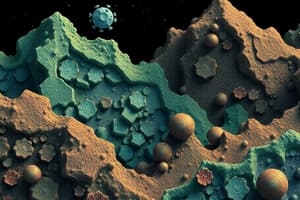Podcast
Questions and Answers
What is the size range of particles possessing colloidal properties in soil colloids?
What is the size range of particles possessing colloidal properties in soil colloids?
- 0.002 - 0.01 mm
- 0.001 - 0.0001 mm
- 0.002 - 0.001 mm (correct)
- 0.01 - 0.005 mm
Which property makes soil colloids expose a large external surface per unit mass?
Which property makes soil colloids expose a large external surface per unit mass?
- Density
- Size (correct)
- Surface tension
- Volume
What is the external surface area of 1g of colloidal clay compared to 1g of coarse sand?
What is the external surface area of 1g of colloidal clay compared to 1g of coarse sand?
- The same
- At least 100 times larger
- At least 1000 times larger (correct)
- Less than coarse sand
What instrument is required to see soil colloids due to their extremely small size?
What instrument is required to see soil colloids due to their extremely small size?
Which type of clays have extensive internal surfaces in addition to external surfaces?
Which type of clays have extensive internal surfaces in addition to external surfaces?
Flashcards are hidden until you start studying
Study Notes
Soil Colloids
- Soil colloids are particles with a diameter of less than 1 micrometer.
- Their small size makes them possess a large surface area per unit mass.
- The surface area of 1 gram of colloidal clay can be up to 800 times greater than that of 1 gram of coarse sand, which is approximately 0.1 square meter.
- An electron microscope is required to view soil colloids due to their extremely small size.
- Clays such as montmorillonite and vermiculite have a large internal surface area in addition to their external surfaces, which provides multiple sites for chemical reactions and ion exchange.
Studying That Suits You
Use AI to generate personalized quizzes and flashcards to suit your learning preferences.




